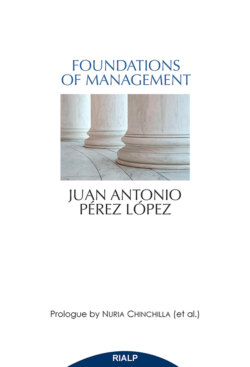Читать книгу Foundations of management - Juan Antonio Pérez López - Страница 26
На сайте Литреса книга снята с продажи.
Motivational conflicts and their relationship to learning
ОглавлениеWhen making a decision, people are often faced with what is called a motivational conflict: some actions are more appealing from one point of view, others from another. Of these, the most important are the so called intermotivational conflicts. In this type of conflict, one action is very appealing, for example, because of extrinsic motives while another is appealing because of another type, and the person must choose one of the two actions. Innumerable examples could be provided for this type of conflict, from the little boy trying to decide whether to go and play, thus displeasing his mother who hopes he will stay home and study, to the salesman who hesitates to close a profitable sale knowing deep down that he is deceiving his customer (provided that the reasons for the hesitation is “not to displease mother” or “not to deceive”; if the hesitation is due to fear of “punishment” should his bad deed be found out, the conflict will not be inter-motivational but rather intra-motivational on the level of extrinsic motives).
It is the resolution of inter-motivational conflicts that shapes a person's motivational quality. That is, if a person ignores the transcendent motives in his decisions, he will find it increasingly more difficult to take them into account. To put it another way: his spontaneous drive or impulse will become increasingly less sensitive to this type of motive.
There is one type of learning that requires that a person be driven by transcendent motives, namely, the growth of evaluative knowledge. This knowledge is what enables him to discover personal realities, that is, the internal states of other persons. The degree to which a person is able to know personal realities is precisely the degree to which he will be able to feel affective satisfactions.
We tend to think that the satisfaction of a person's needs depends solely on what happens outside of that person. This is true in the case of material needs. However, the satisfaction of affective needs depends above all on something within the person: the state of his evaluative knowledge. Even in the case of a person surrounded by other people who really love him, if he has not developed this capacity, his affective needs will remain unsatisfied because he will be unable to discover, and consequently to feel, the affection other people have for him. For this reason it can be said that motivation caused by transcendent motives is the motivation that seeks to guide human action towards personal self-improvement at the very deepest level: the ability to feel other people as such people, the ability to develop deep affective relationships with other human beings.
A person's difficulty in making his decisions consistent with the achievement of his affective self-improvement is to be found in the cost that type of behavior involves. It often happens with inter-motivational conflicts that the spontaneous impulse to achieve extrinsic or intrinsic motives is much stronger than the impulse to achieve transcendent ones. The choice of alternatives aimed at the latter achievement will normally imply a cost of opportunity, that is, a sacrifice with respect to the achievement of extrinsic and/or intrinsic motives that could be achieved by choosing different alternatives.
We will leave these questions aside for the moment, to return to them in the Second Part since, as we have said, for a static analysis of organizations all we need is to have present the three types of motives that can motivate a person’s action when he participates in an organization. When we arrive at the analysis of dynamism, that is, of the learning that takes place within organizations, we will need to start from an analysis of the level of individual learning that happens as a consequence of what people are doing within the organization1.
1 Author's note: The concepts of effectiveness, efficiency and consistency which have been introduced in this chapter play a decisive role in the anthropological theory of organizations. Readers who are familiar with the work of Chester Barnard will no doubt be reminded of the concepts of effectiveness and efficiency that Barnard discovered and applied both to personal action and to organizational action in general (in Chapters 2 and 5, respectively, of The Functions of the Executive). The distinction of Barnard’s is, in my opinion, one of the most significant milestones in the development of the theory of human organizations. The purpose of this note is to acknowledge my intellectual debt to him. This is not the place to develop the theoretical analyses that have led me from the concepts of effectiveness and efficiency in Barnard's theory to those of effectiveness, efficiency and consistency in my own. Readers interested in these issues are invited to read Organizational Theory: A Cybernetical Approach (Barcelona: IESE, Research Paper no. 5, 1974). This paper tries to demonstrate the need for, and the possibility of, a theory that generalizes Barnard's theory by taking into account the dynamism brought about by the decision-maker's learning processes.
